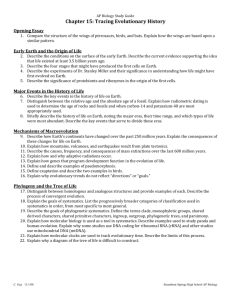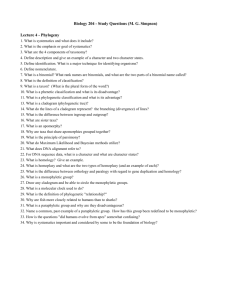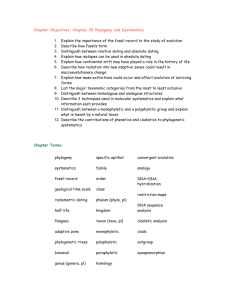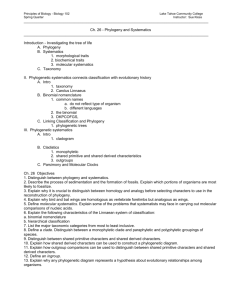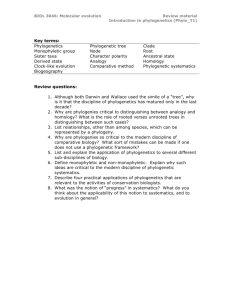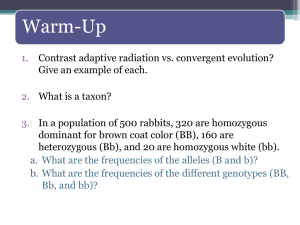Sciences Doctorate School, Eo¨tvo¨s Lora´nd University, Budapest, Hungary
advertisement
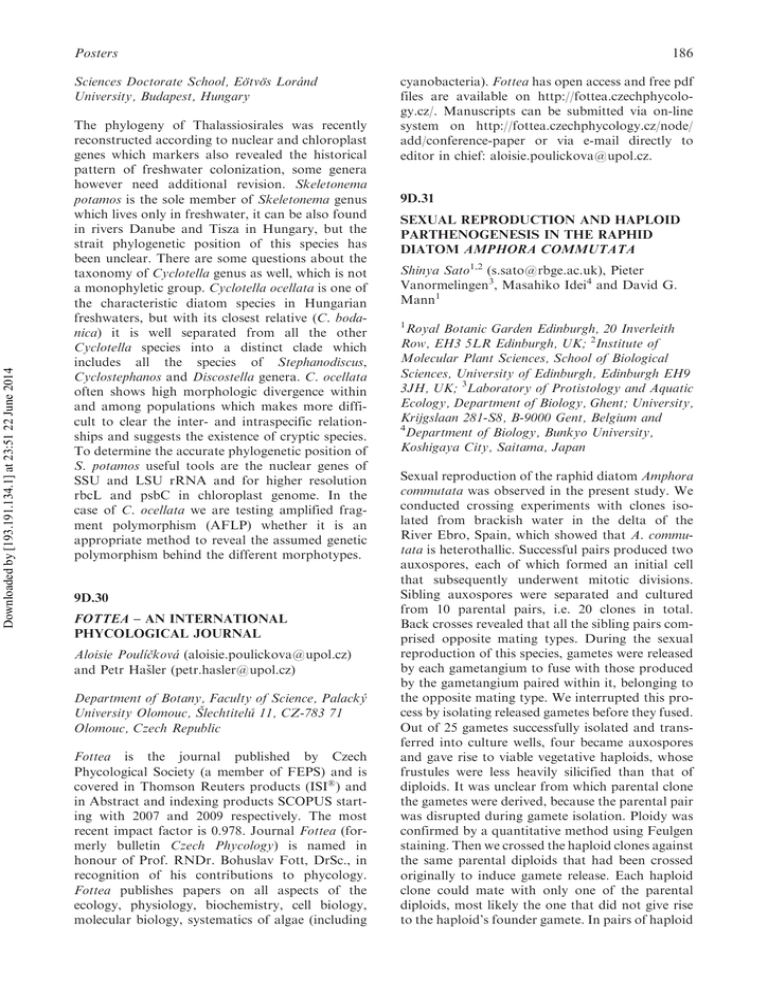
186 Posters Downloaded by [193.191.134.1] at 23:51 22 June 2014 Sciences Doctorate School, Eötvös Loránd University, Budapest, Hungary The phylogeny of Thalassiosirales was recently reconstructed according to nuclear and chloroplast genes which markers also revealed the historical pattern of freshwater colonization, some genera however need additional revision. Skeletonema potamos is the sole member of Skeletonema genus which lives only in freshwater, it can be also found in rivers Danube and Tisza in Hungary, but the strait phylogenetic position of this species has been unclear. There are some questions about the taxonomy of Cyclotella genus as well, which is not a monophyletic group. Cyclotella ocellata is one of the characteristic diatom species in Hungarian freshwaters, but with its closest relative (C. bodanica) it is well separated from all the other Cyclotella species into a distinct clade which includes all the species of Stephanodiscus, Cyclostephanos and Discostella genera. C. ocellata often shows high morphologic divergence within and among populations which makes more difficult to clear the inter- and intraspecific relationships and suggests the existence of cryptic species. To determine the accurate phylogenetic position of S. potamos useful tools are the nuclear genes of SSU and LSU rRNA and for higher resolution rbcL and psbC in chloroplast genome. In the case of C. ocellata we are testing amplified fragment polymorphism (AFLP) whether it is an appropriate method to reveal the assumed genetic polymorphism behind the different morphotypes. 9D.30 FOTTEA – AN INTERNATIONAL PHYCOLOGICAL JOURNAL Aloisie Poulı´cˇková (aloisie.poulickova@upol.cz) and Petr Hašler (petr.hasler@upol.cz) Department of Botany, Faculty of Science, Palacký University Olomouc, Sˇlechtitelů 11, CZ-783 71 Olomouc, Czech Republic Fottea is the journal published by Czech Phycological Society (a member of FEPS) and is covered in Thomson Reuters products (ISI ) and in Abstract and indexing products SCOPUS starting with 2007 and 2009 respectively. The most recent impact factor is 0.978. Journal Fottea (formerly bulletin Czech Phycology) is named in honour of Prof. RNDr. Bohuslav Fott, DrSc., in recognition of his contributions to phycology. Fottea publishes papers on all aspects of the ecology, physiology, biochemistry, cell biology, molecular biology, systematics of algae (including cyanobacteria). Fottea has open access and free pdf files are available on http://fottea.czechphycology.cz/. Manuscripts can be submitted via on-line system on http://fottea.czechphycology.cz/node/ add/conference-paper or via e-mail directly to editor in chief: aloisie.poulickova@upol.cz. 9D.31 SEXUAL REPRODUCTION AND HAPLOID PARTHENOGENESIS IN THE RAPHID DIATOM AMPHORA COMMUTATA Shinya Sato1,2 (s.sato@rbge.ac.uk), Pieter Vanormelingen3, Masahiko Idei4 and David G. Mann1 1 Royal Botanic Garden Edinburgh, 20 Inverleith Row, EH3 5LR Edinburgh, UK; 2Institute of Molecular Plant Sciences, School of Biological Sciences, University of Edinburgh, Edinburgh EH9 3JH, UK; 3Laboratory of Protistology and Aquatic Ecology, Department of Biology, Ghent; University, Krijgslaan 281-S8, B-9000 Gent, Belgium and 4 Department of Biology, Bunkyo University, Koshigaya City, Saitama, Japan Sexual reproduction of the raphid diatom Amphora commutata was observed in the present study. We conducted crossing experiments with clones isolated from brackish water in the delta of the River Ebro, Spain, which showed that A. commutata is heterothallic. Successful pairs produced two auxospores, each of which formed an initial cell that subsequently underwent mitotic divisions. Sibling auxospores were separated and cultured from 10 parental pairs, i.e. 20 clones in total. Back crosses revealed that all the sibling pairs comprised opposite mating types. During the sexual reproduction of this species, gametes were released by each gametangium to fuse with those produced by the gametangium paired within it, belonging to the opposite mating type. We interrupted this process by isolating released gametes before they fused. Out of 25 gametes successfully isolated and transferred into culture wells, four became auxospores and gave rise to viable vegetative haploids, whose frustules were less heavily silicified than that of diploids. It was unclear from which parental clone the gametes were derived, because the parental pair was disrupted during gamete isolation. Ploidy was confirmed by a quantitative method using Feulgen staining. Then we crossed the haploid clones against the same parental diploids that had been crossed originally to induce gamete release. Each haploid clone could mate with only one of the parental diploids, most likely the one that did not give rise to the haploid’s founder gamete. In pairs of haploid 187 Posters and diploid cells, each gametangium produced two gametes and of the four gametes thus formed, two fertilized each other to form viable F2 progeny, whereas the other two remained unfused or formed a zygote that aborted. 9D.32 THREE PENNATE DIATOMS FROM ISCHIA THERMAL DISTRICT (NAPLES, ITALY) Katia Sciuto (katia.sciuto@unipd.it), Emanuela Moschin (emanuela.moschin@unipd.it), Carlo Andreoli (carlo.andreoli@unipd.it) and Isabella Moro (isabella.moro@unipd.it) Downloaded by [193.191.134.1] at 23:51 22 June 2014 Department of Biology, University of Padova, 35131 Padova, Italy Ischia thermal District (Naples, Italy) has been famous since Greek and Roman period for therapeutic purposes and to date the numerous establishments that compose it are attended by thousands of people. As the Euganean District (Padova, Italy), another Italian thermal environment, the surface of Ischia thermal muds is colonized by several organisms, among which cyanobacteria and diatoms. Several surveys have shown the important contribution of Euganean microrganisms to the anti-inflammatory and therapeutic properties of the mud (Tolomio et al. 1999; Lalli et al. 2004; Marcolongo et al. 2006) as well as characterized them (CeschiBerrini et al. 2004; Moro et al. 2007a; 2007b; Moro et al. 2010a, 2010b). On the contrary, Ischia thermal biodiversity has been less investigated, with only one study by Pitschmann dating back to 1969 and a recent survey by Sciuto et al. (2011). Here we report the characterization of three raphid pennate diatoms isolated by two tanks of Ischia thermal District, according to morphological (light microscopy and scanning electron microscopy) and phylogenetic analyses. The phylogenetic analyses have been carried out using the rbcL gene as a molecular marker. The three isolates represent different species from the pinnulariid, naviculoid, and nitzschiid groups. Their precise identification, according to both the morphological and molecular data, is discussed. 9D.33 SYSTEMATICS AND BIODIVERSITY: A JOURNAL DEVOTED TO WHOLEORGANISM BIOLOGY Elliot Shubert (e.shubert@nhm.ac.uk) The Natural History Museum, Cromwell Road, London SW7 5BD, UK Systematics and Biodiversity is a quarterly, international, peer-reviewed life science journal published by Taylor & Francis for The Natural History Museum, London. The journal is devoted to whole-organism biology. The criterion for publication is scientific merit. Systematics and Biodiversity documents the diversity of organisms in all natural phyla, through taxonomic papers, while also addressing topical issues relating to biological collections, and the principles of systematics. It particularly emphasises the importance and multi-disciplinary significance of systematics, with contributions which address the implications of other fields of systematics, or which advance our understanding of other fields through taxonomic knowledge, especially in relation to nature, origins, and conservation of biodiversity, at all taxonomic levels. The Editor does not accept single species descriptions, monographs or serialised part-studies for publication. Taxonomic/systematic manuscripts must include modern methods such as cladistics, phylogenetic analysis, etc. Instructions for authors can be accessed at: http://www.tandf. co.uk/journals/TSAB. Manuscripts should be submitted to: http://mc.manuscriptcentral.com/tsab. The Editor is available to discuss ideas and/or the suitability of preliminary drafts of manuscripts. 9D.34 ECOLOGICAL DIFFERENTIATION OF CRYPTIC SPECIES WITHIN AN ASEXUAL PROTIST MORPHOSPECIES Pavel Sˇkaloud1 (skaloud@natur.cuni.cz) and Fabio Rindi2 (f.rindi@univpm.it) 1 Department of Botany, Charles University in Prague, 12801 Prague, Czech Republic and 2 Università Politecnica delle Marche, Dipartimento di Scienze del Mare, 60131 Ancona, Italy Taxa of microbial eukaryotes defined on morphological basis display a large degree of genetic diversity, implying the existence of numerous cryptic species. However, it has been postulated that genetic diversity merely mirrors accumulation of neutral mutations. We used a cosmopolitan, widely distributed morphospecies of asexual filamentous green algae - Klebsormidium flaccidum (Streptophyta) - as a case taxon to study the cryptic diversity in protists. The concatenated ITS rDNA þ rbcL phylogeny of more than sixty European strains revealed the considerable genetic variability within the K. flaccidum morphotype. The results of inferred character evolution indicated the existence of strong phylogenetic pattern

